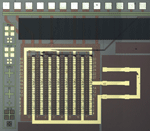As ICs continue to get smaller, their copper conduits are approaching physical performance limitations. Chipmakers have hoped that carbon nanotubes would allow them to continue using thinner wiring as they pack in more devices, but no one had demonstrated nanotube wires working on a conventional silicon chip. EEs at Stanford University (Stanford, CA) and Kawasaki, Japan-based Toshiba’s Advanced Semiconductor Laboratory now report using nanotubes to wire a silicon chip operating at speeds comparable to those of commercially available processors and memory.
“This is the first time anyone has been able to show digital signals going through nanotubes at 1 GHz,” said H.-S. Philip Wong, a professor of electrical engineering at Stanford. “There had been a lot of expectations that nanotubes could do this, but no experimental proof so far.”
The research shows that nanotubes are capable not only of connecting transistors at industrially relevant speed but of doing so in real circuits that use materials compatible with those that chipmakers use today, according to Gael Close, an EE doctoral student and co-author with Professor Wong of a paper on the subject.

A prototype 11,000-transistor chip contains select interconnections made of carbon nanotubes instead of copper wires. (Image by Gael Close)
Wong, Clos, and their collaborators built an array of 256 ring oscillators to test the design and included control to selectively operating each of the oscillators, the chip comprised a total of 11,000 transistors in an area 0.01 in.2 Visit http://nano.stanford.edu for more information.
Jim Harrison
Advertisement
Learn more about Stanford University





